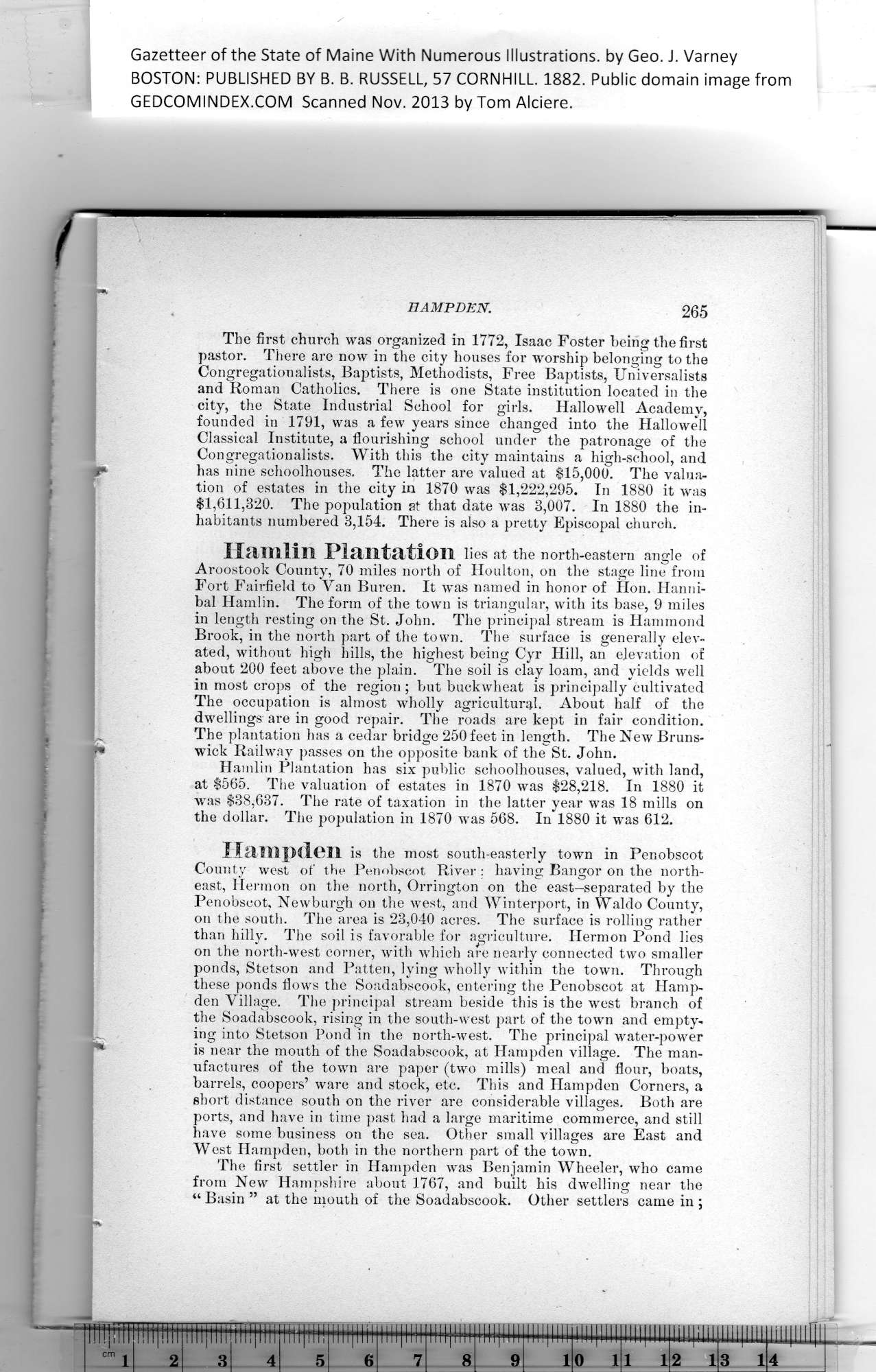|
Gazetteer of the State of Maine With Numerous Illustrations, by Geo. J. Varney
BOSTON: PUBLISHED BY B. B. RUSSELL, 57 CORNHILL. 1882. Public domain image from
HAMPDEN. 265
The first church was organized in 1772, Isaac Foster being the first
pastor. There are now in the city houses for worship belonging to the
Congregationalists, Baptists, Methodists, Free Baptists, Universalists
and Roman Catholics. There is one State institution located in the
city, the State Industrial School for girls. Hallowell Academy,
founded in 1791, was a few years since changed into the Hallowell
Classical Institute, a flourishing school under the patronage of the
Congregationalists. With this the city maintains a high-school, and
has nine schoolhouses. The latter are valued at $15,000. The valua-
tion of estates in the city in 1870 was $1,222,295. In 1880 it was
$1,611,820. The population at that date was 3,007. In 1880 the in-
habitants numbered 3,154. There is also a pretty Episcopal church.
Hamlin Plantation lies at the north-eastern angle of
Aroostook County, 70 miles north of Houlton, on the stage line from
Fort Fairfield to Van Buren. It was named in honor of Hon. Hanni-
bal Hamlin. The form of the town is triangular, with its base, 9 miles
in length resting on the St. John. The principal stream is Hammond
Brook, in the north part of the town. The surface is generally elev-
ated, without high hills, the highest being Cyr Hill, an elevation of
about 200 feet above the plain. The soil is clay loam, and yields well
in most crops of the region; but buckwheat is principally cultivated
The occupation is almost wholly agricultural. About half of the
dwellings are in good repair. The roads are kept in fair condition.
The plantation has a cedar bridge 250 feet in length. The New Bruns-
wick Railway passes on the opposite bank of the St. John.
Hamlin Plantation has six public schoolhouses, valued, with land,
at $565. The valuation of estates in 1870 was $28,218. In 1880 it
was $38,637. The rate of taxation in the latter year was 18 mills on
the dollar. The population in 1870 was 568. In 1880 it was 612.
Hampden is the most south-easterly town in Penobscot
County west of the Penobscot River ; having Bangor on the north-
east, Hennon on the north, Orrington on the east—separated by the
Penobscot, Newburgh on the west, and Winterport, in Waldo County,
on the south. The area is 23,040 acres. The surface is rolling rather
than hilly. The soil is favorable for agriculture. Hermon Pond lies
on the north-west corner, with which are nearly connected two smaller
ponds, Stetson and Patten, lying wholly within the town. Through
these ponds flows the Soadabscook, entering the Penobscot at Hamp-
den Village. The principal stream beside this is the west branch of
the Soadabscook, rising in the south-west part of the town and empty,
ing into Stetson Pond in the north-west. The principal water-power
is near the mouth of the Soadabscook, at Hampden village. The man-
ufactures of the town are paper (two mills) meal and flour, boats,
barrels, coopers’ ware and stock, etc. This and Hampden Corners, a
short distance south on the river are considerable villages. Both are
ports, and have in time past had a large maritime commerce, and still
have some business on the sea. Other small villages are East and
West Hampden, both in the northern part of the town.
The first settler in Hampden was Benjamin Wheeler, who came
from New Hampshire about 1767, and built his dwelling near the
“ Basin ” at the mouth of the Soadabscook. Other settlers came in :
PREVIOUS PAGE ... NEXT PAGE
This page was written in HTML using a program written in Python 3.2
|
